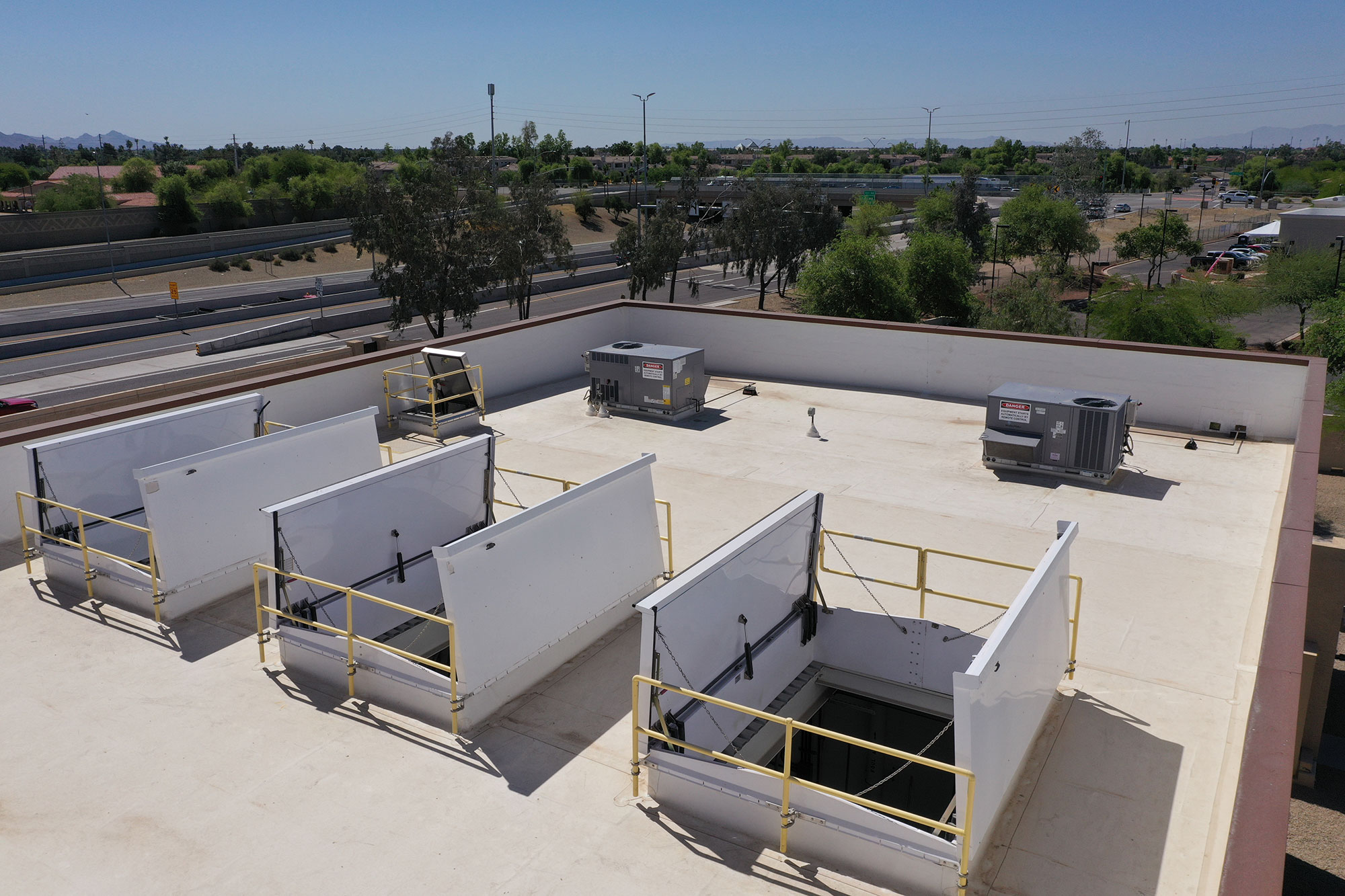Roof Hatches Simplified
Safety, convenience, codes, and fire ratings
Sponsored by The BILCO Company | By Kathy Price-Robinson
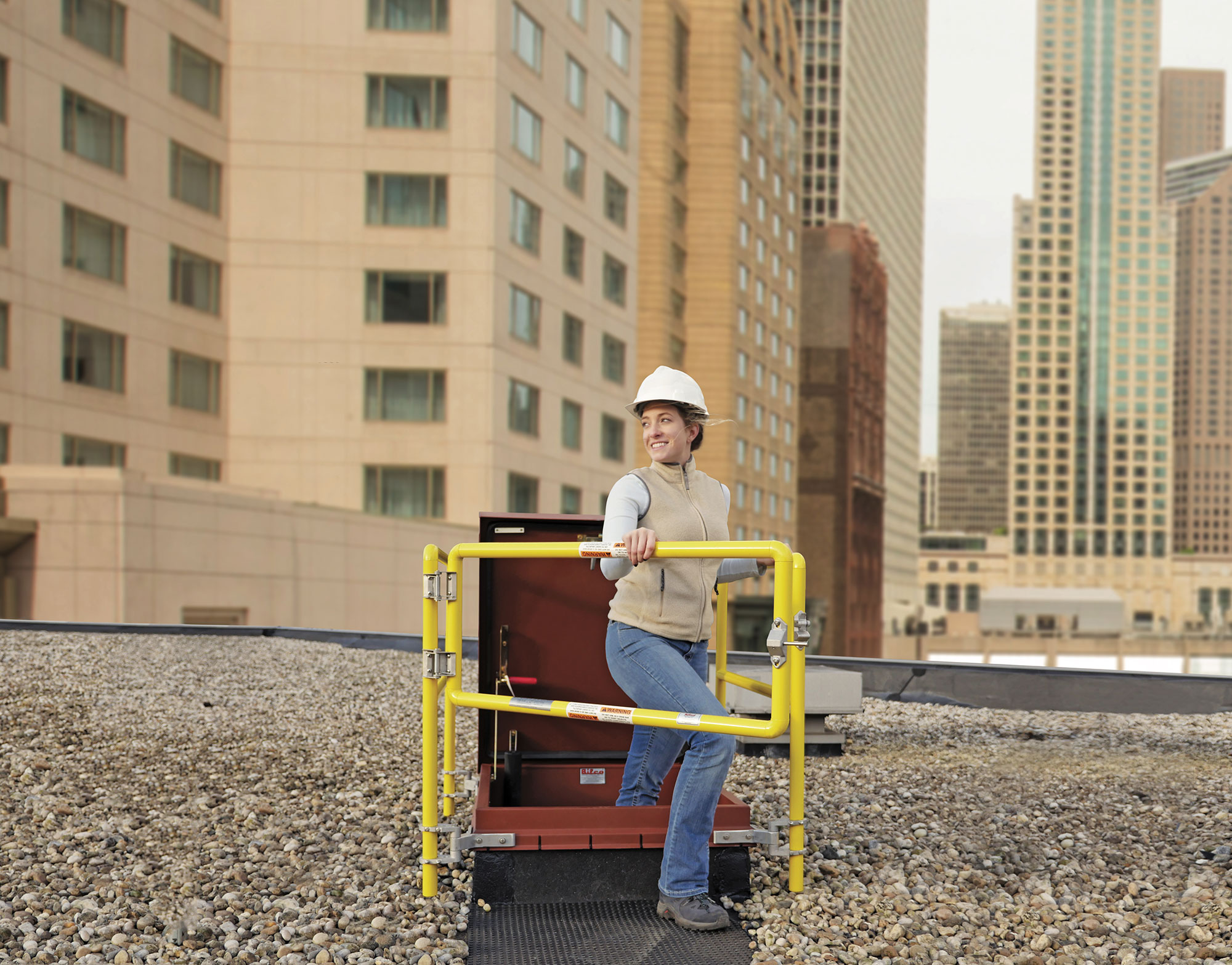
Photo courtesy of The BILCO Company
Roof hatches with rails provide safe and convenient access to the roof.
Roof hatches are a common building component used to access the roof. In commercial settings, they are commonly installed to access the roof area for maintenance purposes, such as air treatment systems, air conditioning units, and other mechanical systems. They are installed at hospitals, offices, industrial buildings, retail facilities, and any commercial building that requires rooftop access. In single-family residential and multi-family applications, they can provide access to rooftop decks, which is a growing trend.
This course explores the features and benefits of roof hatches, their design, and options for enhanced performance. The course dives into pertinent building codes for hatches, their specific language (or lack thereof), and the existing consensus among fire protection experts regarding fire protection ratings requirements for roof hatches. The definition of these requirements has caused some confusion among architects, construction managers, and code enforcement officials which will be addressed in this course.
THE FUNCTION AND BENEFITS OF ROOF HATCHES
Roof hatches provide safe and convenient access to roof areas by means of an interior ladder, ship stair, or service stair. Hatches typically feature engineered lift assistance for easy one-hand operation.
When architects and contractors think of roof hatches, they typically envision a standard 36-inch-by-30-inch hatch allowing a technician to service a rooftop air conditioning unit on a commercial building by means of a fixed ladder. But the applications for roof hatches are so much more diverse than that. For instance, as we’ll see later in the course, roof hatches give building occupants access to ever-more-popular rooftop decks that increase usable living space and provide views. Hatches are also available in custom sizes to provide an accessible way to install or remove large pieces of equipment from a building.
The Case of Ochsner Medical Center in New Orleans
Consider the case at Ochsner Medical Center in New Orleans and the massive piece of state-of-the-art medical equipment that needed to be installed in a building.
The options for maneuvering a 21-ton, multi-million piece of life-saving medical equipment within a medical facility are limited. The team at Woodward Design+Build found its solution with a custom-sized roof hatch.
The Louisiana-based construction company renovated a 9,000-square-foot space for an oncology suite at Ochsner. The suite links to the Gayle and Tom Benson Cancer Center, which opened in 2020 after the completion of a two-year, $56 million expansion. The oncology suite expansion occurred in a building that dates back to the mid-20th century.
One of the most significant challenges for Woodward centered on installing a Gamma Knife into the building. Only about 300 facilities worldwide have the $7-million device, which uses radiation and computer-guided planning to treat brain tumors, vascular malformation, and other abnormalities of the brain.
Treatment with the Gamma Knife is a non-invasive alternative to traditional brain surgery. In the procedure, high-dose beams of the cobalt-60 radiation converge on selected areas deep within the brain to treat the patient.
The Gayle and Tom Benson Cancer Center is a linchpin to cancer patients in New Orleans and offers a holistic, patient-centered approach that is among the nation's most advanced cancer treatment centers.
Cranes lowered the device into the building through a custom 12-foot-by-9-foot roof hatch. The roof hatch features engineered lift assistance to allow for easy, one-hand operation despite its large size and, most importantly, weather-tight construction, given the exorbitant cost of the medical equipment directly below the hatch.
"We needed a customized hatch solution for the size of the opening," said Ryan Kersten, Project Manager for Woodward. "The roof hatch company really fit the bill and was able to accommodate the varying sizes that we looked at. The size of the hatch grew in design as we completed the design phase."
In the future, medical workers must access the Gamma Knife unit periodically for maintenance and repair. The radiation source in this sophisticated medical device, cobalt-60, has a half-life of 5.3 years. The roof hatch will allow workers to replace the radiation source as necessary without removing the equipment. "They will have to replenish the radiation source by going in through the roof, so this hatch allows them access to do that," Kersten said. "There isn't any other way to do that."
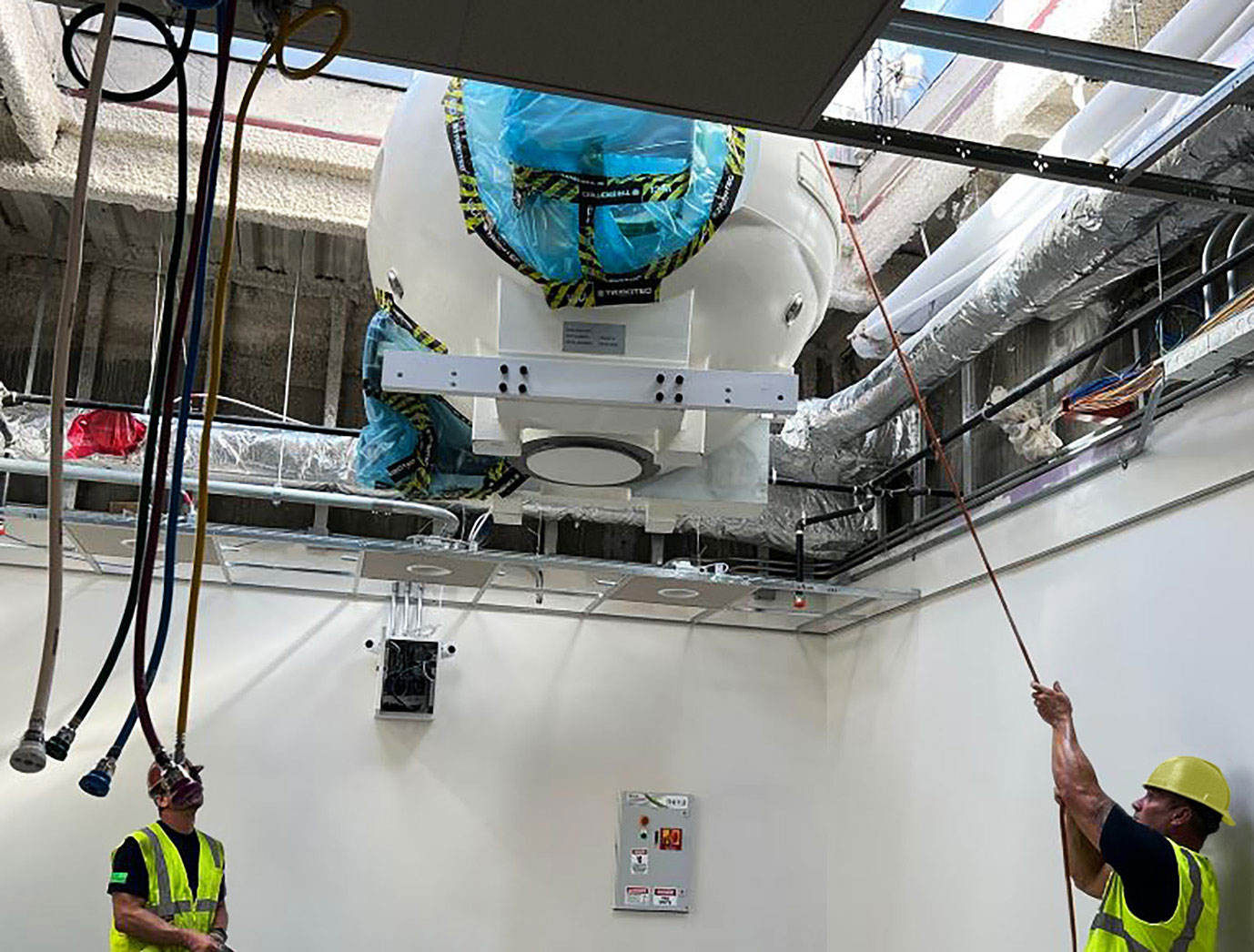
Photo courtesy of Woodward Design+Build
A large roof hatch allows this massive Gamma Knife unit to be lowered into an oncology suite at Ochsner Medical Center in New Orleans.
Roof Hatches Provide Easy Access for Colorado Water Reclamation Facility
Rapidly growing cities and their need for infrastructure have increased the need for reliable roof hatches.
For instance, Parker, Colorado, has grown from less than 300 residents a few decades ago to more than 60,000 in 2021.
As the community expanded, keeping up with infrastructure improvements remained a concern. The most recent was the overhaul of the North Water Reclamation Facility (NWRF). Garney Construction completed a three-year, $57-million project that expanded the facility from 2 million gallons per day (MGD) to 3.8 MGD.
The complex project included the construction of a new headworks facility and the establishment of new plant power and distribution. The requirement to maintain plant operations throughout construction made the immense scope of the project more challenging.
Garney installed 10 roof hatches in the reclamation facility to provide workers with access to equipment for maintenance and replacement purposes.
Consistency of equipment was a priority, according to Stephanie Sansom, Senior Project Manager for the Parker Water & Sanitation District. Therefore, the specified roof hatches were manufactured by the same company as the existing ones throughout the district. "We haven't had problems with their hatches in the past,” she said. “So why change something if it's already working? It makes it easier on operations and maintenance when we've got the same equipment throughout the district."
The manufacturer’s hatches are commonly used in projects associated with wastewater management. The hatches feature corrosion resistance and safe, easy one-hand operation.
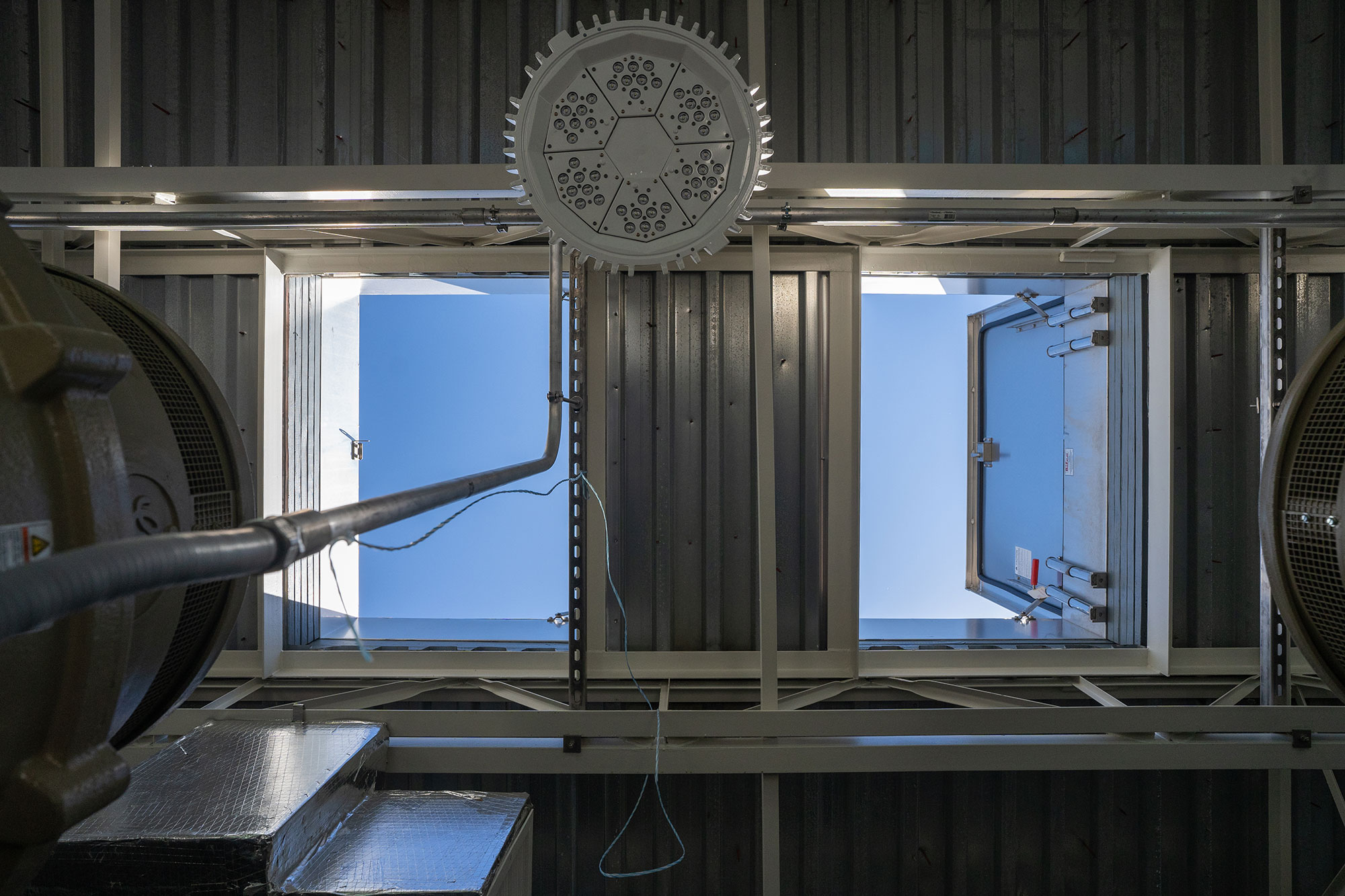
Photo courtesy of Jenn Bakker/Breathtakingmomentsphotography.com
Ten roof hatches at a reclamation facility in Parker, Colorado, provide workers with access to equipment for maintenance and replacement purposes.
DESIGN FEATURES OF ROOF HATCHES
The key design features of modern roof hatches can impact the overall building performance and durability of a commercial roof. Here are factors to consider:
Size
Roof hatches are available in a wide range of sizes. There are numerous factors to consider when selecting a hatch size for a particular application. First, determine whether the hatch will be used simply to gain access to a roof or whether it is needed to install or remove equipment from a building.
Small or single-cover models should be specified if a hatch is used only for personnel access. These models typically are used with a fixed ladder, ship stair or service (full-size) stair. Roof hatch size is defined by measuring its inside frame opening, and the roof opening should be roughly the same as the hatch size.
Some industry-standard sizes are:
- 36 x 30 or 36 x 36 inches for ladder access
- 30 x 54 inches for ship- or steep-stair access
- 30 x 96 inches for service stair access
A building's type and size generally will determine the method of egress, which, in turn, determines roof hatch size. For example, a large building, such as a manufacturing facility with high ceilings, may require the use of a fixed ladder to gain access to a roof area, but an office building or school could incorporate a staircase into a structure's upper level.
Frequency and reason: The frequency and reason individuals need to access a roof area can also affect hatch size. If maintenance personnel will be required to carry large tools or parts onto a roof for service, a larger hatch with stair access should be considered.
In addition to personnel access, larger roof hatch sizes are available for installing or removing equipment from a building. Whether a building is an office building, hospital, or manufacturing facility, equipment type, and dimensions will determine its roof hatch size.
Roof hatches designed for equipment access are generally two-cover models custom-manufactured to specific size requirements. When determining the size of a hatch for a particular piece of equipment, it is essential to contact the roof hatch manufacturer to verify the hardware locations on the hatch and the clear opening of a specific size.
Material Choice and Corrosion Resistance
Another important consideration when selecting a roof hatch is its material. Typically, this decision depends on cost, aesthetics, maintenance considerations, and a hatch's geographic location. Hatches are manufactured in galvanized steel, aluminum, and stainless steel.
Galvanized steel is the most common material choice. It provides basic corrosion resistance and is typically supplied with a primer paint finish. Aluminum hatches have a mill finish and are slightly more expensive than galvanized steel. However, they offer a higher level of corrosion resistance, particularly in coastal areas, and require little or no finish maintenance.
Stainless steel roof hatches are also available, but there is a significant premium for these products. Stainless steel hatches offer the highest corrosion resistance and are installed in environments such as chemical plants or coastal areas with extreme weather conditions.
Energy Efficiency
Energy efficiency is essential for all buildings, and a properly constructed roof hatch will help maintain the energy performance levels of an efficiently constructed building. To help maximize energy efficiency, selecting hatches that feature fully welded corners and insulation in the cover and curb is crucial. Many hatch manufacturers also offer insulation options for enhanced thermal performance. Roof hatches should also feature an overlapping cover design and a full perimeter gasket to ensure complete weatherproofing.
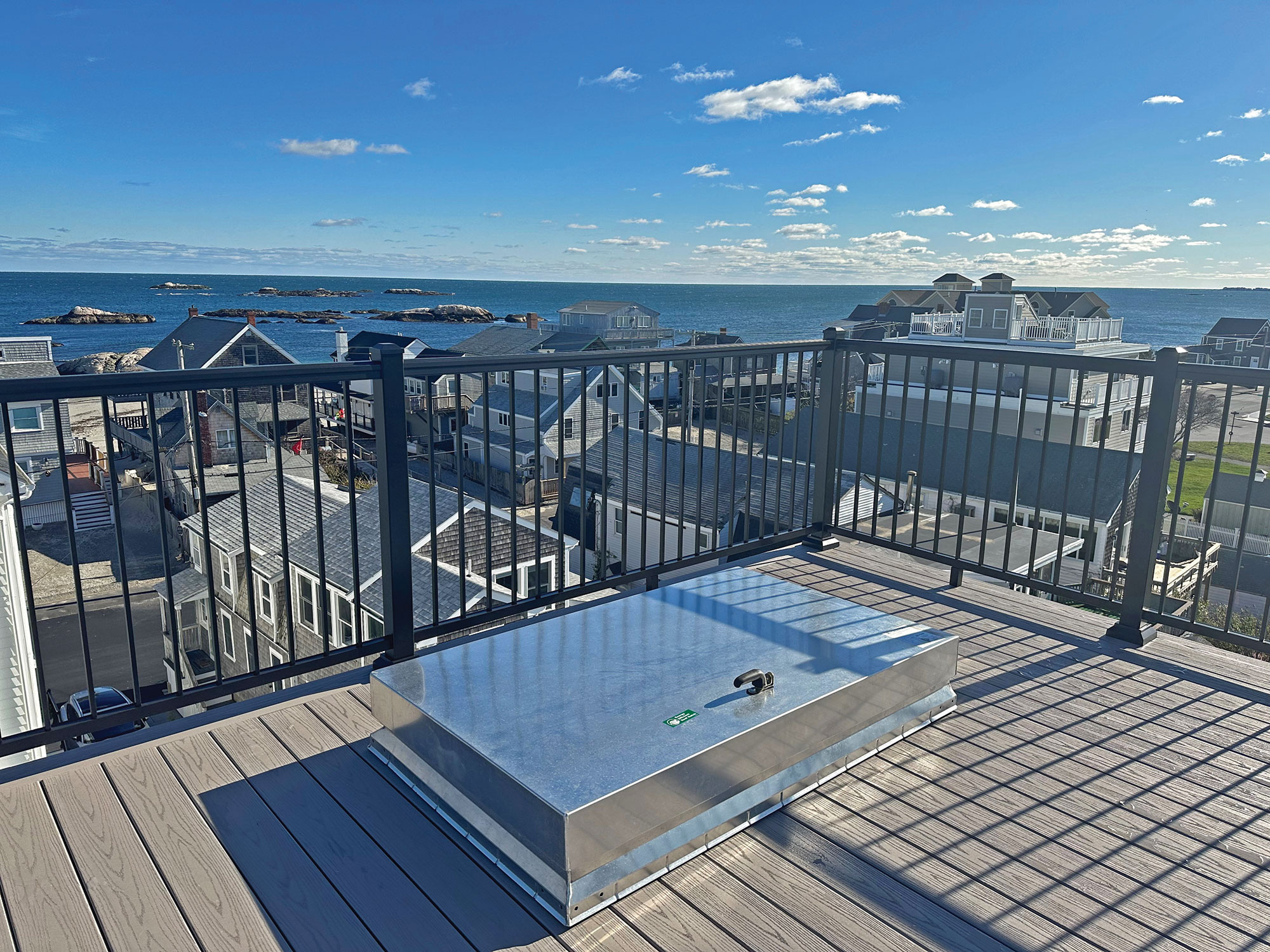
Photo courtesy of Lee Cormier and The BILCO Company
Energy efficiency is essential for all buildings, and a properly constructed roof hatch will help maintain the energy performance levels of an efficiently constructed building.
Lifting Mechanism
Operation is one of the critical factors to consider when specifying a roof hatch. Workers usually need to raise a hatch upward from inside while standing on a ladder or stairs, often carrying tools, so every hatch should be equipped with properly designed lift assistance. These devices should provide uniform lift assistance to ensure smooth, easy operation and minimize the effort required to open and close the hatch.
In addition, proper lift assistance and an automatic hold-open arm ensure the cover will not slam shut on users while entering or exiting a hatch.
Another option is an electric motor operation to open and close covers with the push of a button. The motor operation provides a convenient means of ventilating work areas in manufacturing facilities. The product typically includes a built-in motor operator, a push button control station, and a wiring diagram.
Roof hatches can also be supplied with manual winch operation to open and close covers remotely. Winch operation provides a convenient means of ventilating work areas in manufacturing facilities and is a less expensive alternative to electric motor operation. The product usually includes a manual winch and wall mounting bracket. Cable and additional pulleys can generally be supplied at additional cost.
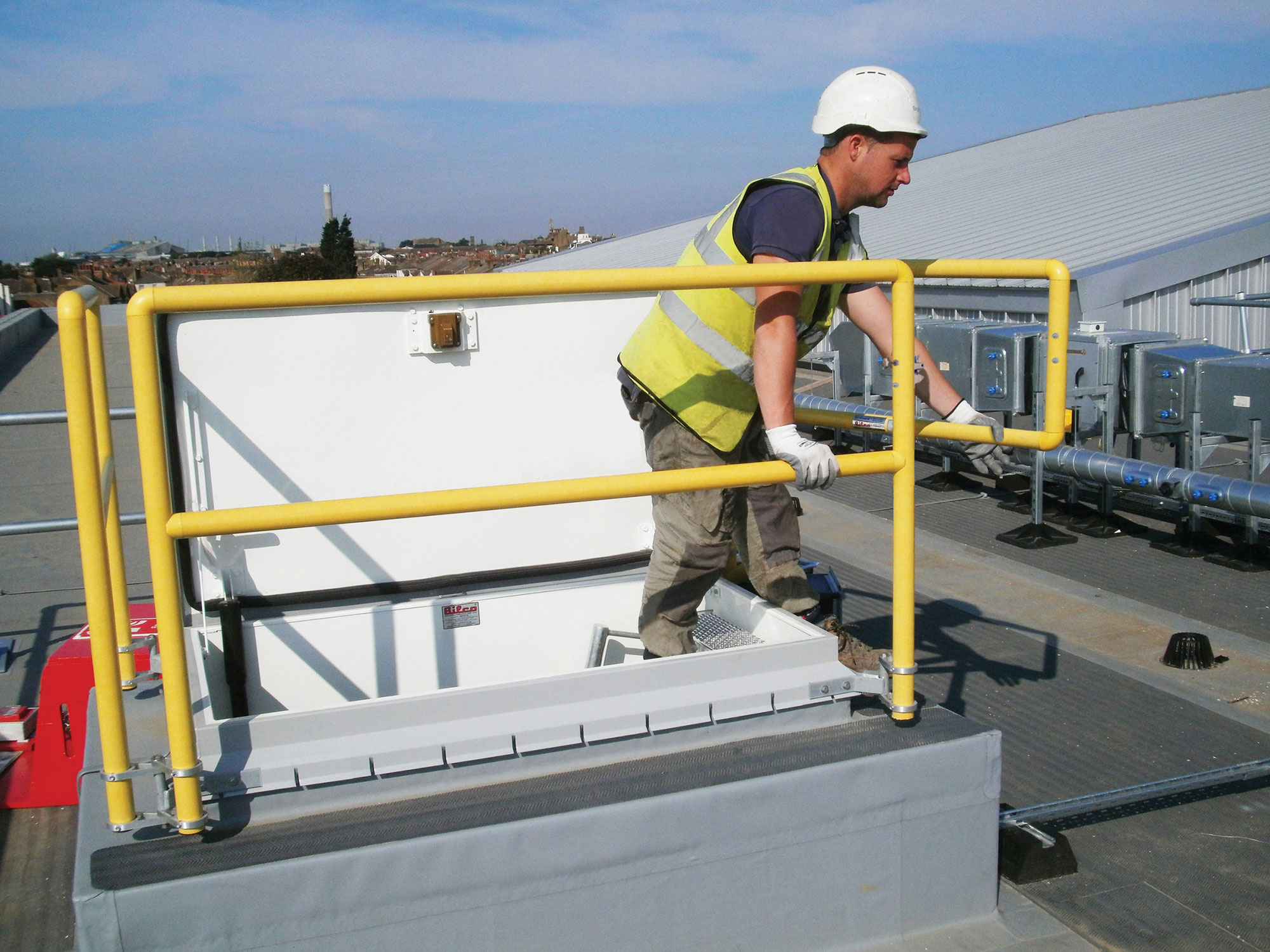
Photo courtesy of Lee Cormier and The BILCO Company
Fall protection is the main function of a roof hatch safety railing system.
Locking Options
Most roof hatches are supplied with interior and exterior padlock hasps as a standard feature to prevent unauthorized access. Custom security options can include keyed cylinder locks and contact switches for alarm systems. For high-security buildings such as prisons, banks, or pharmacies, hatches can be fabricated from heavier gauge materials and modified with numerous options to enhance security.
Meeting OSHA Safety Requirements
A safety railing system on a fixed roof hatch provides a permanent means of fall protection for roof hatch openings. In addition to OSHA fall protection regulations (29 CFR 1910.29), it is important to consider the features and benefits developed by manufacturers for hatch railing systems.
Some common factors to consider when choosing a railing system are:
- The design should allow the railing system to be installed on the roof hatch without penetrating the roofing material. If designed otherwise, the installation of a railing might result in a potential leak path.
- Installation should be simple and require only basic hand tools with no installation training or certification necessary.
- The railing system should be constructed of corrosion-resistant materials such as stainless steel, or aluminum.
- The railing system manufacturer should provide a warranty to ensure product quality.
The roof hatch industry also has made products available to complement railing systems for additional worker safety. One such product is a ladder safety post, an extension device that permanently mounts to the top two rungs of a fixed ladder. It provides a steady handhold that enables workers to enter or exit an opening in an upright, balanced position. This product type should feature adjustable mounting hardware to accommodate any ladder rung size or spacing.
In addition to safety options for roof hatches, the OSHA minimum required size for ladder access roof hatches often comes into question. For many decades, the industry standard for ladder access has been 36 inches (width) by 30 inches (length) hinged on the short side. OSHA 29 CFR 1910.27 fixed ladders standard defines the requirements for design and installation of fixed ladders and associated components, such as roof hatches and cages.
This standard states that ladder rungs are required to be at least 7 inches from the ladder mounting surface as measured to the centerline of the rungs. If a ladder is installed so that the climber’s back faces a smooth wall, the minimum distance from the centerline of the rung to the wall is 27 inches. In this case, the required minimum hatch width would be 34 inches, and the industry standard size would be compliant. When a smooth wall is not present, the minimum distance to any obstruction behind the climber as measured from the centerline of the rungs is 30 inches. This dimension, coupled with the 7-inch rung clearance, equals 37 inches, which causes some confusion in the market regarding the use of the industry standard 36-inch-wide ladder access roof hatch.
To accommodate the industry-standard roof hatch width in these rare applications, OSHA has permitted the use of adding a deflector plate at the point where any obstruction reduces the 37-inch dimension. The deflector plate is defined within the Standard and is typically not provided by the roof hatch manufacturer.
Custom Options
In addition to the options already discussed, roof hatch manufacturers offer more options to customize a product to suit a particular application without compromising features or performance. Some additional custom options include:
Curb options can simplify installation on various roof systems. Roof hatches can be supplied with curb liners or fully enclosed curbs for installation on existing curbs. Curbs can be modified to be installed directly on standing-seam metal roof panels. This modification allows a hatch to sit directly on a metal roof, eliminating the need for a job-built curb.
Hatches can be specified with a polycarbonate dome cover to provide the added benefits of a skylight. The cover allows natural light into a building, possibly reducing energy costs and providing a more pleasant building environment.
Louvers incorporated into the hatch curb provide continuous, passive ventilation into a building.
Special finishes are available from hatch manufacturers for added corrosion resistance or to allow a hatch to match a building's exterior. Common finish options include anodized aluminum and paint finishes such as Kynar, Tnemec, and powder coat paint.
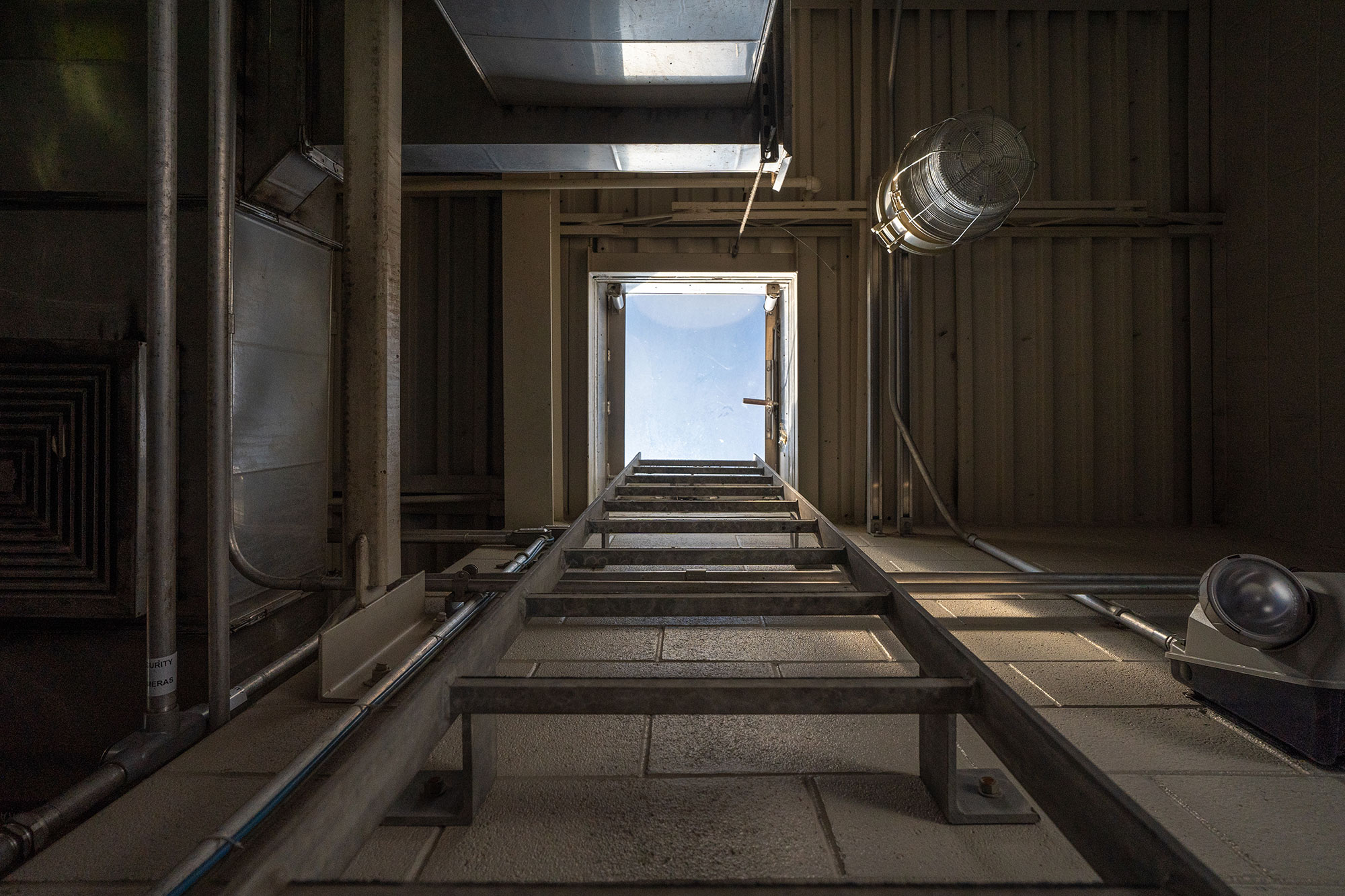
Photo courtesy of Jenn Bakker/Breathtakingmomentsphotography.com and The BILCO Company
A roof hatch with fixed-ladder access.
Thermally Broken Roof Hatch
Thermally broken roof hatches (frame and cover) are designed to minimize heat transfer and the effects of condensation. Depending on the manufacturer, they may feature up to R-20 or greater insulation and a frame and cover design that minimizes heat transfer between interior and exterior metal surfaces.
Here are some typical features of thermally broken hatches and their benefits:
- Thermally broken covers and curbs reduce heat transfer between interior and exterior surfaces to resist harmful condensation.
- When used, ozone-friendly polyisocyanurate insulation (R-20+) provides superior energy efficiency.
- Superior gasketing enhances weather and wind resistance.
- May meet LEED® standards for recycled content.
- Possible high solar reflective index (SRI).
- The components may dampen vibration for improved acoustic performance against outside noise.
Rooftop Deck on Cape Cod Residence
An excellent example of a custom roof hatch can be found on a home in Scituate, Massachusetts, where a thermally broken roof hatch allows for energy efficiency as well as breathtaking ocean views.
Growing up on Cape Cod in Massachusetts, builder PJ Antonik knew rooftop decks are highly coveted by residents who yearn for views of the nearby Atlantic Ocean. What the builder did not realize is how challenging they can be to construct.
Antonik, the founder and CEO of Oak Development Design, and his team constructed a three-and-a-half-story home with a 500-square-foot rooftop terrace. The house's ridgeline sits 40 feet in the air, allowing homeowners and their guests unparalleled ocean views. They access the terrace with a custom-built ladder, passing through a thermally broken roof hatch.
The 3,400-square-foot home is located in a four-unit development, all designed by Oak Development & Design, just one block from Cohasset Harbor. All four homes have roof decks. "This is the only one with a roof hatch," Antonik said. "They will have a wide-open view of the Atlantic, and the sun sets behind you. If you're going to build a three-and-a-half-story home with the Atlantic close by, it's a massive miss if you don't have an ocean view. It's the kind of thing that pushes the potential buyer over the edge to make an offer."
Antonik designed roof access through a skylight-style window accessed by a traditional staircase in three of the homes. Rooftop access for the final house came right through the center of the roof. "We had to do an internal custom ladder, and I've never done that before," he said. "It was especially interesting to figure out how to frame it."
Antonik deliberated about how to access the roof before deciding on the thermally broken roof hatch, which measures 48 inches by 32 inches. "I wanted to keep it to a very low profile, so we mounted it on the framing down on the rubber roofing and framed around it, so it's not sticking way up on the roof. It sounds easy, but it was actually pretty complex, especially never having done it before."
Antonik said he tried other roof hatch models but found them hard to open. The selected hatch was specified for its superior energy performance and because it is easy to open and close. The hatch features counter-balanced lift assistance for easy, one-hand operation and an automatic hold-open arm. The frame and cover design minimizes heat transfer between interior and exterior metal surfaces and delivers year-round energy efficiency. "Roof hatches are hard to find," Antonik said. "This one was easy to install and easy to work with. The thermally broken aspect to it made it a great choice to help reduce energy consumption."
Homeowners with houses close to a body of water enjoy views year-round. However, the architect or builder must creatively design a solution that provides those views. "Every bit of view you can get is really worth it aesthetically," the builder said. "We wanted to capitalize on the beach and the views it can provide, and the hatch made that possible."

Photo courtesy of Lee Cormier and The BILCO Company
Providing access to rooftop decks on residential properties has become an attractive amenity.
STYLES OF ROOF HATCHES AND COMMON APPLICATIONS
As discussed, the specification of roof hatches depends on many factors, including how they will be used. Here are some roof hatch styles and their applications.
Fixed Ladder Access
For fixed ladder access, an easy, one-hand operation to the fully open or closed position is necessary to provide the user the security of having one hand firmly on the ladder at all times. That means a counter-balanced design. Roof hatches are generally available in galvanized steel, aluminum, or stainless steel and can include dome covers for natural daylighting. The standard size of 36 inches by 30 inches may be increased to 36 inches by 36 inches for easier ladder access and to remove or install small pieces of equipment in a building.
Ship or Steep Stair Access
Ship or steep stair access hatches, typically 30 inches by 54 inches (762mm x 1372mm), are helpful for installations where frequent use may be expected. They permit easier movement of maintenance personnel, tools, and equipment.
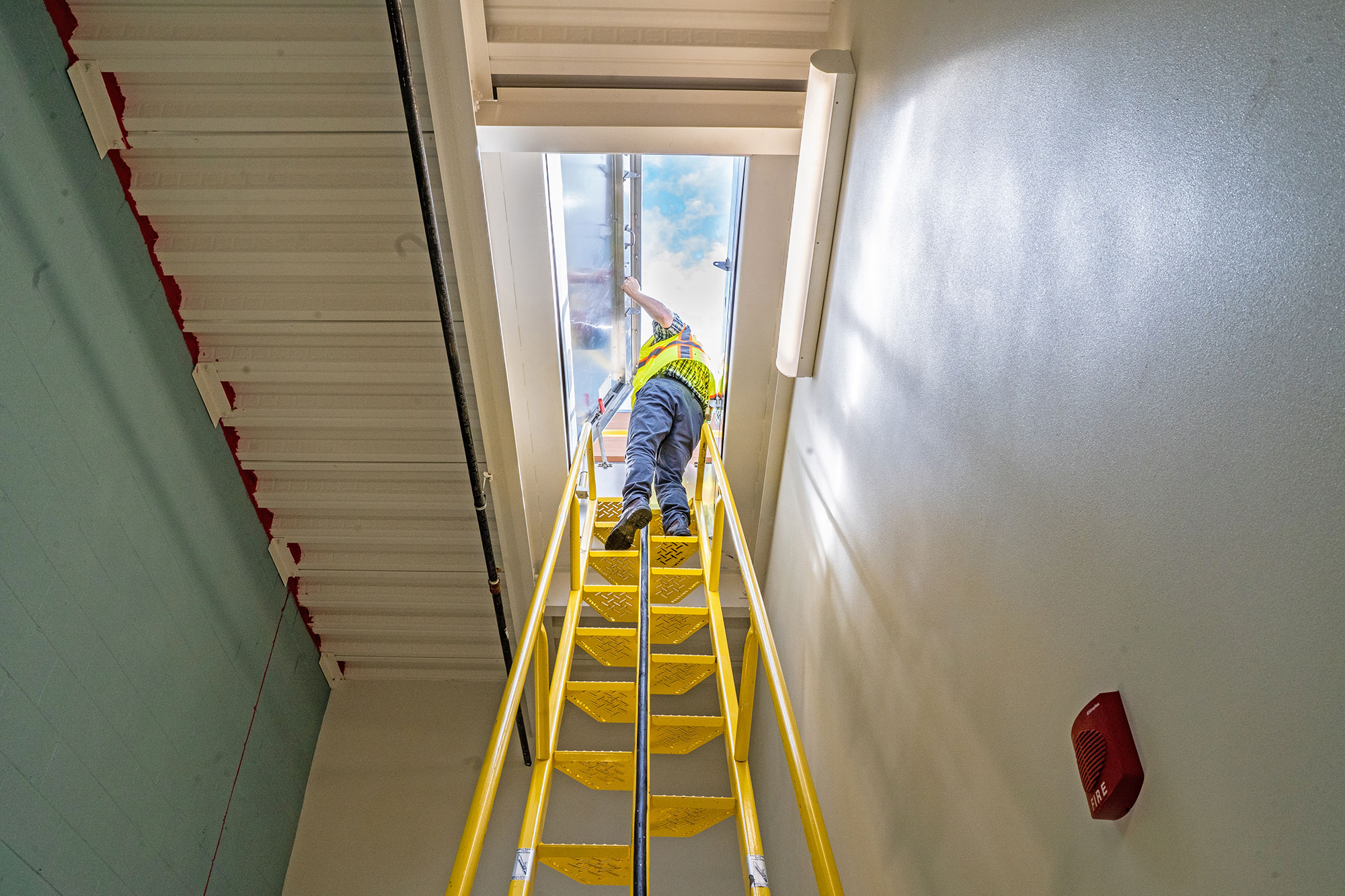
Photo courtesy of The BILCO Company and Gill Couto Photography
A roof hatch with full-service stair access.
Service or Full-Service Stair Access
Service or full-service stair access is appropriate for installations where even more frequent use may be expected. They permit easier movement of maintenance personnel, tools, and equipment from a full-size stairway.
Equipment Access
As we have seen, a larger opening provides an easily accessible means for equipment to be installed or removed from a building. Equipment access roof hatches can be custom fabricated to meet any size requirement as shown in the large hatch discussed earlier in the course. Special single-leaf sizes are generally available, depending on the manufacturer, and are recommended for widths up to 5 feet (1524 mm). For larger openings, architects should specify double-leaf construction. For best operation, specify aluminum construction for single-leaf hatches over 3 feet (914 mm) wide and double-leaf hatches over 7 feet (2134 mm) wide.
Thermally Broken Roof Hatch: Capitol Hill Buchanan Park Condos
Thermally broken roof hatches added functionality to Capitol Hill Buchanan Park Condos. While the historic buildings, monuments, and scenery around Washington D.C., draw tourists from all over the world, tenants of 32 new townhomes in the city's swanky Capitol Hill will have a unique and private vantage point to the area with individual roof hatches.
Buchanan Park is a residential development built by Ditto Residential to include 41 condominiums in a redeveloped historic three-story school building dating back to 1895 and named after James Buchanan, the nation's 15th president. Buchanan Park includes a central green, multiple outdoor gathering areas, and pedestrian walkways.
The 32 three- and four-bedroom townhomes will line 13th and D Streets in Washington, D.C., surrounding the Buchanan School. Inspired by the Federal-style homes in the neighborhood, the townhomes will include brick exteriors and spacious living areas.
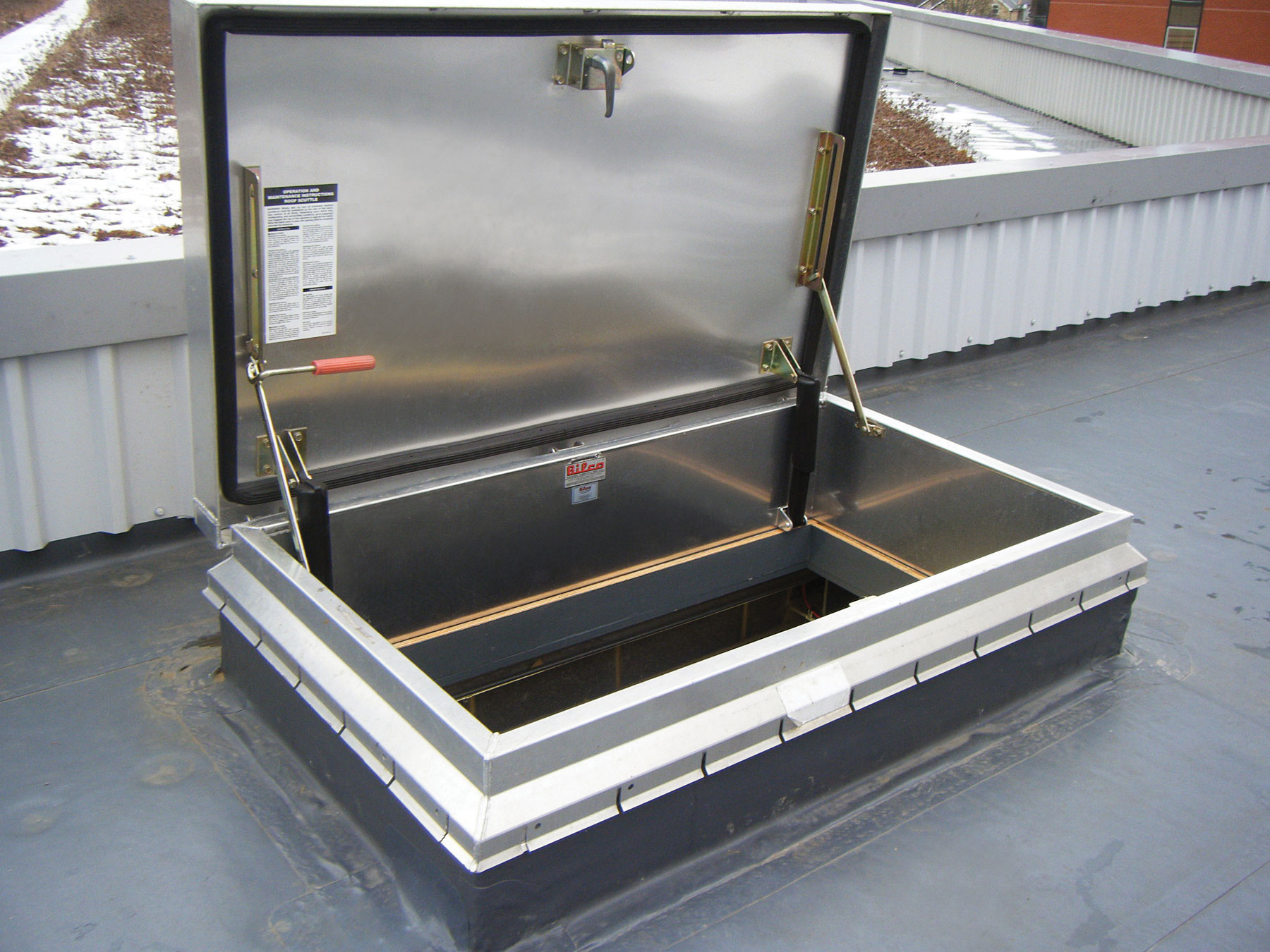
Photo courtesy of Jenn Bakker/Breathtakingmomentsphotography.com and The BILCO Company
A roof hatch with ship stair access.
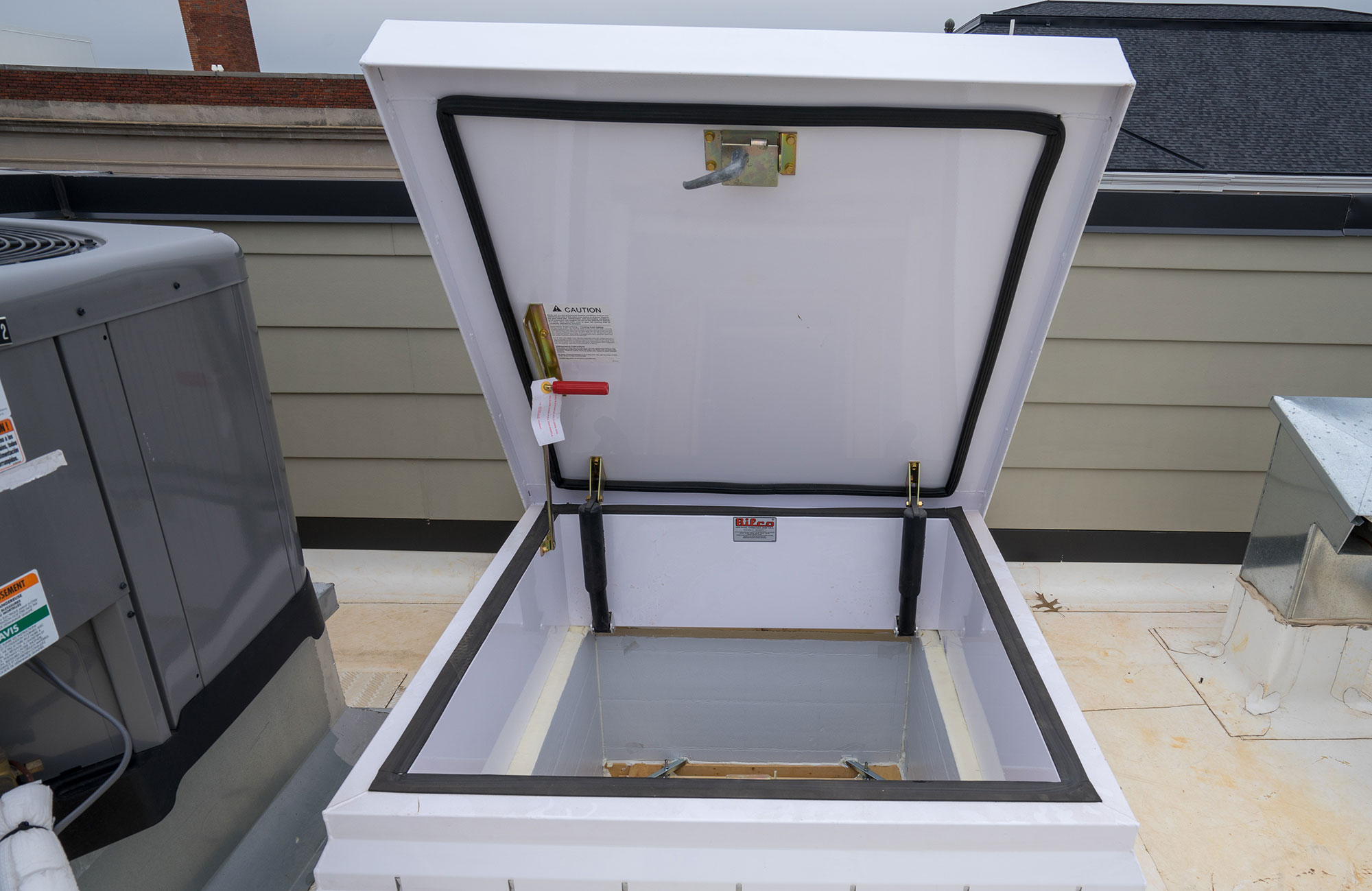
Photo courtesy of Studio Trejo
Tennants of 32 new townhomes have roof access thanks to roof hatches.
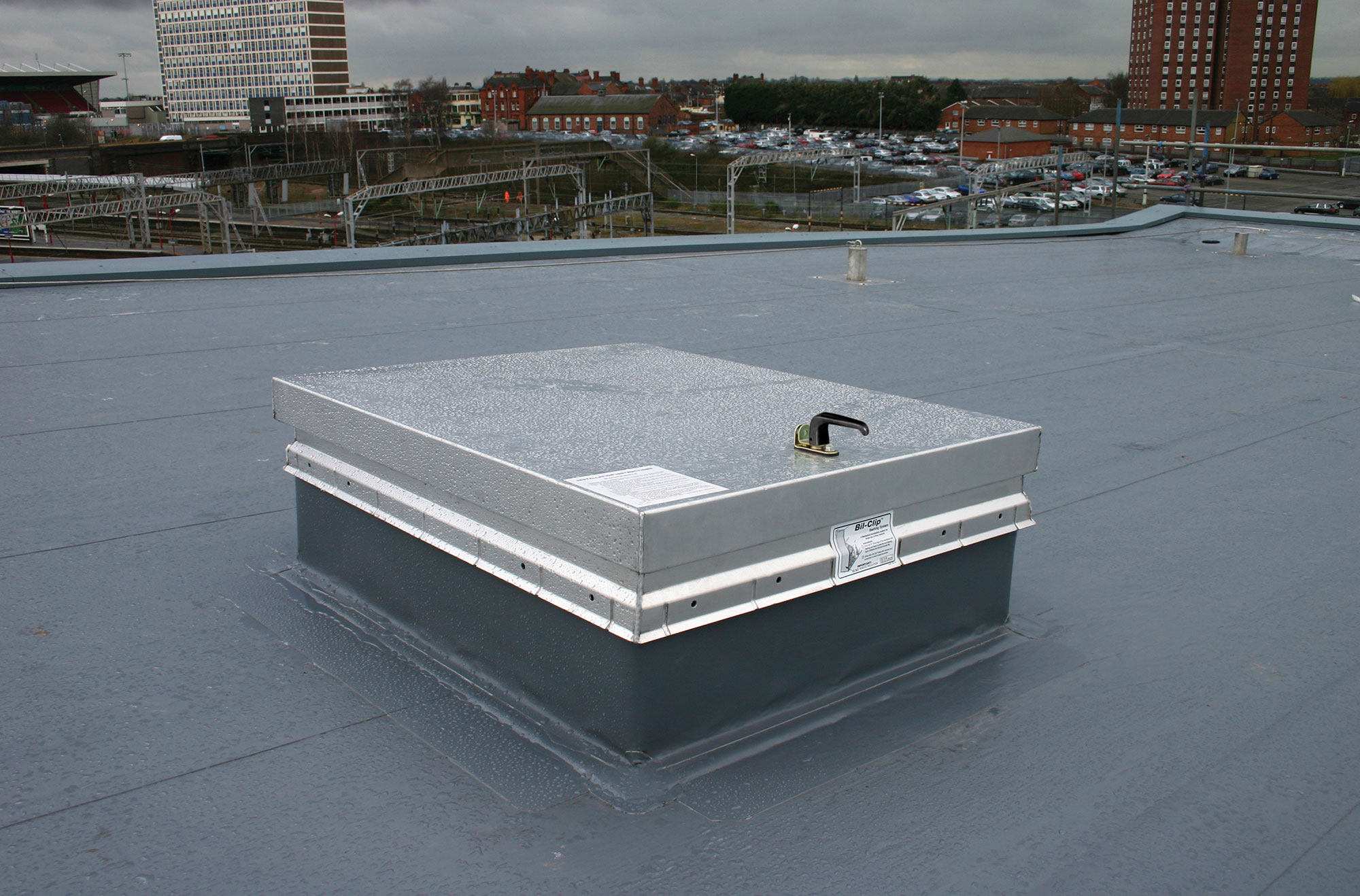
Photo courtesy of The BILCO Company
A thermally broken roof hatch.
The architect for the townhomes, Maurice Walters, designed them to provide residents with individual access to rooftop deck areas. DJB Contracting installed 32 thermally broken roof hatches, manufactured by an established company, to meet the architect's request.
"We have used (this company’s) roof hatches all the time," said Eric Ward, project manager for DJB, whose business has been providing roofing and related services to the Washington area for more than two decades. "We had never used the thermally broken roof hatches before this project. I think it's a good fit for the situation. It's an access point to the roof, and I like that they are pre-fabricated and pre-coated. It makes the job a lot easier."
The thermally broken roof hatches offer a new standard in energy efficiency, making them ideal for the project at Buchanan Park. The hatch minimizes heat transfer and the effects of condensation. The unit includes a thermally broken cover and curb featuring R-20+ insulation. The unit also offers corrosion-resistant aluminum construction.
"The increased R-value makes this hatch superior to its competitors in the industry," Ward said. "Typically, roof hatches don't have much insulation in the cover. It's made of aluminum, too, while others are made of steel around the base. It's much lighter. I like this model because it's lighter and maintenance-free."
Ward believes the residents of the townhomes will appreciate the roof hatches. Besides increasing energy efficiency, they will allow residents rare private access to their roofs. Most city housing projects offering rooftop access accommodate multiple tenants, not individual access.
"I think the hatch will work great," Ward said. "I've never seen this application before, but I think it's a great idea, and tenants will find that they really like this product."
BUILDING CODES, STANDARDS, AND FIRE PROTECTION
Codes play a critical part in all building projects, especially regarding fire protection. The International Building Code (IBC) does not explicitly address a fire protection rating for roof hatches. Fire protection experts primarily refer to Section 712.1.15 concerning Skylights. This section states that "unprotected skylights and other penetrations through a fire-resistance-rated roof deck or slab are permitted provided that the structural integrity of the fire-resistance-rated roof assembly is maintained."
This means that, in most cases, roof hatches are not required to be fire-rated, even in fire-rated roofs, as they are not a structural component of the roof assembly. However, a rarer scenario arises when Section 705.8.6 of the IBC, addressing Vertical Exposure, comes into play. It stipulates that if a building is within 15 feet of another building or has a stepped roof, non-rated roof hatches (or skylights) are not permitted, as they would affect the fire separation requirements. In these cases, fire-rated access doors are required as defined in Section 712.1.13.2.
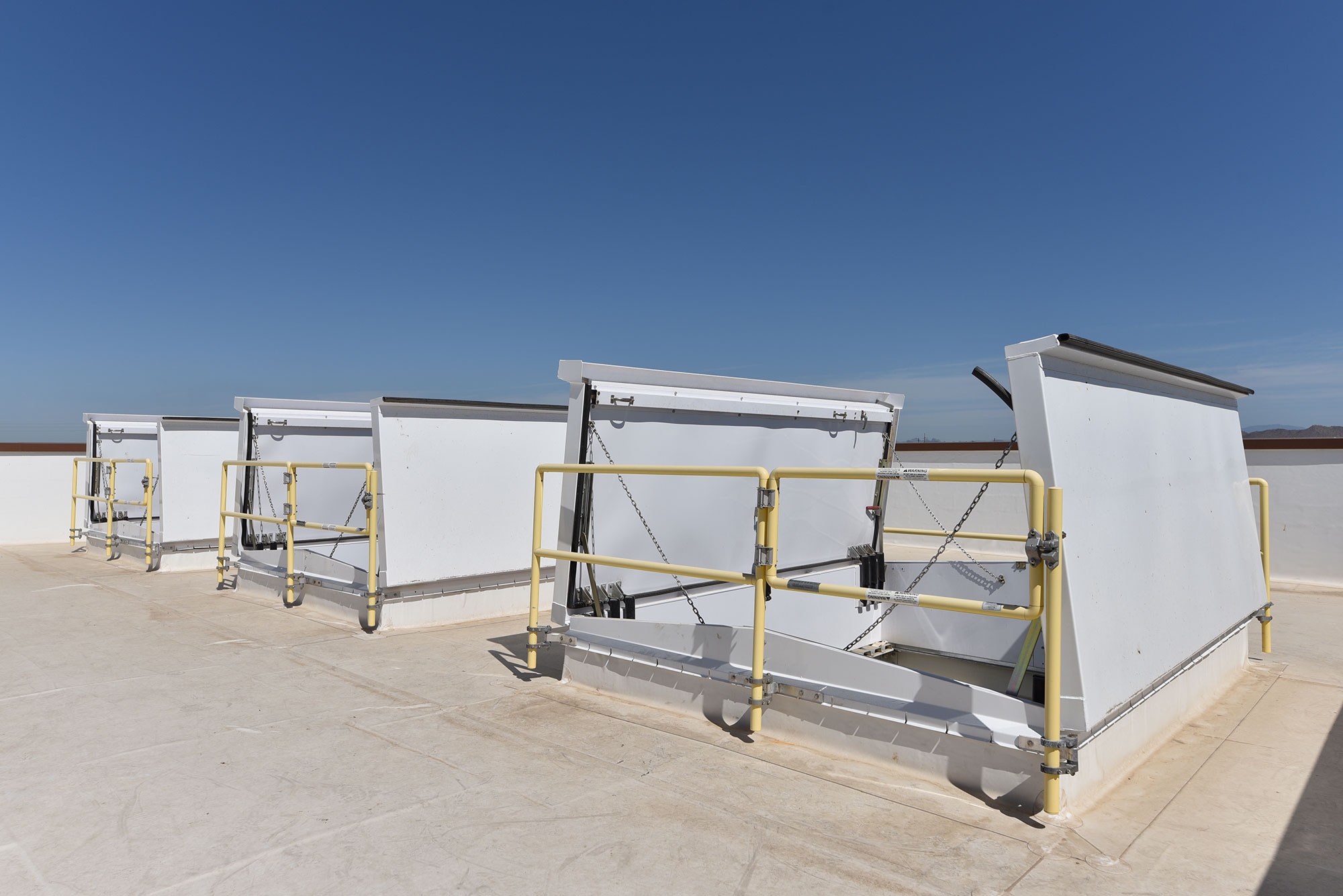
Photo courtesy of The BILCO Company and Gill Couto Photography
Roof hatches for equipment access.
A Deeper Dive
The IBC Commentary of Section 712.1.15 elaborates on this issue, emphasizing that:
"Fire-resistance-rated roof construction is not intended to create a barrier to contain the fire within the building, except for Exception 1 of Section 705.8.6 and the exception to Section 706.6.1. Nonfire-resistance rated penetrations are, therefore, permitted to be installed in fire-resistance-rated roof assemblies, provided that the structural integrity of the roof assembly is not reduced and provisions of Section 705.8.6 for protection of vertical exposure do not apply."
A Perspective
Section 711 of the IBC addresses Floor and Roof Assemblies. While this section does not directly mention roof hatches, it requires horizontal assemblies to be continuous with vertical openings, as regulated by Section 712.
It further states that penetrations or openings in the assembly are permitted according to Section 712, provided that the fire-resistance rating is maintained. This provision could lead some code enforcement officials to question whether non-rated roof hatch installations in fire-resistant horizontal assemblies are permitted. However, as noted above, Section 712.1.15 allows non-fire-rated hatches in rated assemblies.
Manufacturers of roof hatches assert that their products are not integral parts of roof assemblies and, therefore, do not impact a roof's fire-resistance rating or the structural integrity of the roof. IBC Section 1501 states that a Roof Assembly is "A system designed to provide weather protection and resistance to design loads. The system consists of a roof covering and roof deck or a single component serving as both the roof covering and the roof deck. A roof assembly includes the roof deck, vapor retarder, substrate or thermal barrier, insulation, vapor retarder and roof covering."
The inclusion of roof hatches within the definition of a roof assembly is not stipulated. Therefore, it is appropriate to adhere to Section 712.1.15, which permits skylights and other penetrations through a fire-resistance-rated roof deck or slab to be unprotected. This allowance is applicable assuming that Section 705.8.6, which concerns vertical exposure for buildings on the same lot, does not apply.
Outreach Efforts
While outreach efforts have revealed a consensus among fire protection officials that fire protection ratings for roof hatches are typically not mandatory, it is crucial to acknowledge the potential for variations in interpretation by code officials, particularly in jurisdictions that may have local code amendments or ordinances in place. Such variations can arise with any code provision. Therefore, it remains best practice for architects and construction managers to proactively engage in collaborative discussions with code officials to ensure adherence to the building codes before commencing construction. This proactive approach will help preempt discrepancies and ensure alignment with the local code interpretations and requirements.
European Products
There is often confusion surrounding European products entering the U.S. market, particularly concerning roof hatches marketed as fire-rated. These products undergo testing according to European standards, specifically EN1634-4 and UL-EU, which are not referenced in the IBC or applicable to U.S. fire protection standards.
Despite these European roof hatches incorporating non-combustible mineral wool insulation and achieving fire ratings to European standards, the IBC generally does not recognize these products or mandate fire ratings for roof hatches, even within fire-rated assemblies. This situation raises questions about the applicability and relevance of such products for the U.S. construction market.
HVHZ Zones Approval
While certain jurisdictions may require roof hatches to comply with the Florida Building Code, including the High-Velocity Hurricane Zone (HVHZ), changing weather patterns and record-breaking wind events make such compliance desirable in other areas as well. Roof hatches are available on the market to meet Florida Building Code requirements and assemblies must pass a series of tests to achieve a Notice of Acceptance (NOA) from Miami-Dade County’s Department of Regulatory and Economic Resources, Board and Code Administration Division. Those tests include Air Infiltration Test, Uniform Static Air Pressure Test, Water Resistance Test, Large Missile Impact Test, and Cyclic Wind Pressure Test.
CONCLUSION
Roof hatches are an important part of any commercial building and many residential properties, providing access to roof areas for a variety of purposes. Careful selection of a roof hatch, including its construction material, ease of operation, safety features, and any necessary options, will determine its service life and required maintenance.
Although roof hatches are convenient for personnel working on rooftops, they can create a hazard when left open and unattended. To ensure worker safety, it is crucial to understand OSHA regulations regarding fall protection and roof hatches. Specifying proper roof hatches and code-compliant safety equipment is paramount to making rooftop environments safe and comfortable workplaces.
Building codes also play a crucial role in construction projects, yet their lack of clarity can sometimes lead to confusion. To mitigate ambiguity, it could be beneficial for a subsection to be developed in the IBC, specifically addressing roof hatches. Until such a change occurs, treating roof hatches and skylights similarly in alignment with the prevailing expert consensus is a prudent approach during pre-construction planning.
With proper planning and specification by architects and builders, high-quality roof hatches bring safety, functionality, convenience, durability, and energy efficiency to a wide variety of building applications.
Kathy Price-Robinson writes about building and design. Her “Pardon Our Dust” remodeling series ran for 12 years in the Los Angeles Times. She specializes in writing about buildings that are durable and resilient to climate disruption and products and designs that provide shade in hot climates. www.kathyprice.com
For more than 90 years, The BILCO Company has been a building industry pioneer in the design and development of specialty access products for both commercial and residential projects. The ISO 9001-certified company is a wholly owned subsidiary of AmesburyTruth, a division of Tyman PLC. BILCO.com.
Originally published in Architectural Record
Originally published in August 2024
LEARNING OBJECTIVES
- Explain the function and benefits of roof hatches for commercial buildings and their safety requirements.
- Describe the different styles of roof hatches and common applications.
- Discuss how building codes and standards impact the specification of roof hatches, especially regarding fire protection and safety.
- Identify key features of modern roof hatches that can impact the energy efficiency of a building. Learn about the future and growing trends for roof hatch products.

